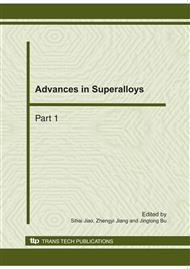p.262
p.267
p.272
p.277
p.281
p.288
p.293
p.297
p.301
Research on Internal Stress in Electroplated Cu Films on Fe Substrates and Ni Substrates - Based on Electron Theory
Abstract:
Electroplating was employed to prepare Cu films on Fe substrates and Ni substrates. The average internal stresses in Cu films were measured in situ by cantilever beam test. The distribution of the internal stresses in Cu films was investigated. The results show that the average internal stresses and the distributed internal stresses in Cu films decrease abruptly with the increase of film thickness when the films are thinner. The interfacial stresses in Cu films are very large and growth stresses are very small. The average internal stresses in Cu films, which were caused by the adjustment of the electron densities at either side of the interface, were calculated roughly using a modified Thomas–Feimi–Dirac electron theory. For the same substrate and the same film, the theoretical value of the average internal stress in film is about equal to the experimental value. It shows that the theoretical calculation model of internal stress is of accuracy.
Info:
Periodical:
Pages:
281-287
Citation:
Online since:
October 2010
Authors:
Keywords:
Price:
Сopyright:
© 2011 Trans Tech Publications Ltd. All Rights Reserved
Share:
Citation:


